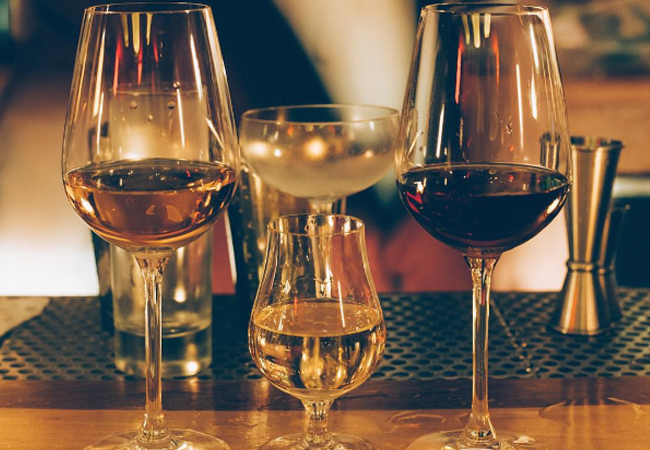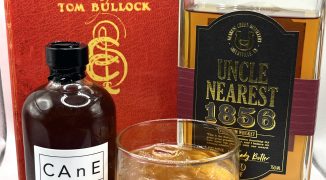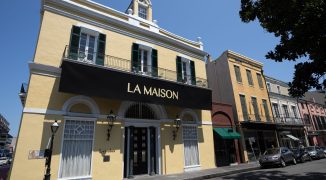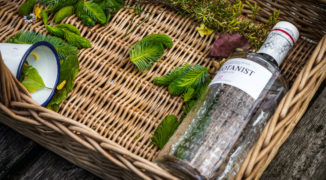Bartenders spend a lot of time thinking about ice and how it changes a drink, from the ways that it can shift the temperature, texture and taste of a cocktail to the ways its more creative applications can up the ante on presentation. But in the last year, one particularly interesting format has captured the attention of some craft bartenders: drinks made with no ice at all.rn
Despite recent attention, room temperature drinks are not a new phenomenon. In fact, up until the end of the 19th century, they were quite common — ice, in those days, was a luxury item and not an essential for working barmen. Fast-forward to last year, when Jim Kearns opened Slowly Shirley, the subterranean bar tucked beneath The Happiest Hour. “John Henderson, the original head bartender at Slowly Shirley, put forward a room temp drink and I thought it was kind of a funny idea, kind of cheeky,” says Jim. “I didn’t know what to make of it. Everybody kept talking about that drink, and I started to think about it myself. I got kind of interested in the idea.” The bar ended up devoting a section of their menu entirely to room-temperature cocktails.rn
We’ve long been curious about the technical aspects of developing room-temp recipes. So, we asked Jim Kearns himself to join us for a recent stream to give us the lowdown on what to consider when building these drinks. Read below for a few highlights, plus the full video recap of Jim’s demo:
Use the room temp format to highlight aged spirits or those with interesting nuances.rn
In the rum cocktail that Jim demonstrated for us, the Captain Ron, the drink’s temperature underscores the myriad dimensions of the spirits used in the drink, from Ron Zacapa to Aperol and Averna. “What you end up with is a very dark spirited, aromatic cocktail that pulls out some of the nuances in Ron Zacapa, with dark chocolate and orange pulled out by the Aperol and Averna, and a little sweetness added by demerara,” he says. “You get a really nice dark chocolate profile out of this drink.”rn
But, delicate ingredients shine in these drinks, too.rn
While an aged rum or nuanced amaro will certainly be brought forward in room-temperature drinks, this format is also perfect when you’re working with a lighter spirit or set of ingredients that run the risk of getting overpowered or shut down by the chill of the cocktail. The Sun Also Rises, another drink from Slowly Shirley’s room-temp menu, makes use of beautiful but very delicate ingredients, such as blanche armagnac, pacharan (a Spanish sloe liqueur), and French quince liqueur. “There was just no way to make this a chilled drink and have it make any sense, so I tried it at room temp,” says Jim. “This is room temp fulfilling its second function — to allow lighter elements, or a drink made entirely of lighter elements, to shine.”
Minimize your variables by adding water.
“Water is part of all of our room temp cocktails,” Jim says. He explains that, even though it isn’t a historically accurate addition, it makes it easier for him to minimize the number of other variables in the drink. “What we wanted to do was keep the number of variables that we were eliminating, if we weren’t going to be adding chill to these things, down to a minimum. So, we kept the dilution in the drink to make it a little more palatable and less firey for people, and added water, but just at room temperature.” He adds that ¾ teaspoon seems to be a magic number for several of the drinks they’ve developed, but of course, every cocktail will need to be calibrated differently.
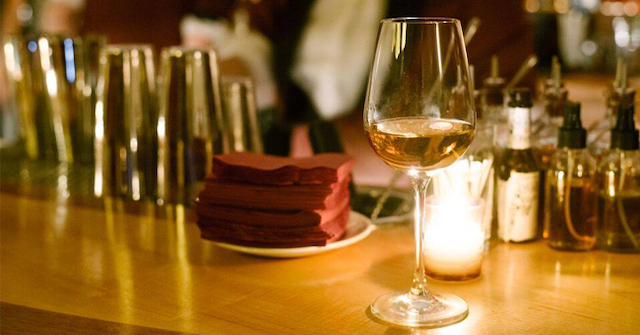 With blanche armagnac, Spanish sloe liqueur and French quince liqueur, The Sun Also Rises is a perfect example of using room temperature to highlight more delicate flavors.
With blanche armagnac, Spanish sloe liqueur and French quince liqueur, The Sun Also Rises is a perfect example of using room temperature to highlight more delicate flavors.
No spirit is off-limits, but some do require a bit of caution.
We asked Jim if he’d ever had a run-in with a spirit that was just ultimately never meant to be used in a room-temperature cocktail. “I have a hard time coming up with one,” he says. “I would say for things like gin, I would play with cautiously, but I would have a hard time thinking of anything else.” While sky’s the limit with experimentation, a good rule of thumb is to look at how these spirits are best served on their own. “A lot of the stuff that we ended up using are spirits that could very easily be consumed at room temp, and in some cases are arguably better served at room temp,” he adds.
Start experimenting now: these are ideal for cooler weather.
Guests coming in off the streets at the height of summer probably won’t be thrilled with a lukewarm glass of booze, no matter how good the composition is. But that’s all the more reason to start experimenting now, because these drinks are ideal for cooler months. Jim also sees them as an excellent alternative to dealing with the logistics of hot drinks (like, he says, a hot plate at the bar), while still offering guests something that feels warming and cozy.
They’re perfect to make ahead for events and parties.
“These are easy to do for a party,” Jim says, “because they don’t over-dilute while they’re sitting, or change, or get too warm.” They’re easy to batch and good for serving to large groups of people, he says, “as long as your friends are graduate-level drinkers.” Which brings us to our next point:
Not everyone will appreciate these (so make sure your menu wording is crystal-clear).
Jim’s ideal demographic for selling these drinks: spirit aficionados. “People who like to drink booze and who can appreciate it by itself, who are used to tasting spirits, are the people most likely to identify with these cocktails and appreciate them,” he says. “They are definitely not novice cocktail drinker-compatible as much as some of the other drinks on the menu. I probably wouldn’t encourage someone who wants a light, easy cocktail to drink them.” That said, make sure guests know what they’re getting into: at Slowly Shirley, this section on the menu states “room temperature” pretty prominently. “We gave people enough information to understand that the drinks were being served at room temp, and if they didn’t glean it from that, we’re happy to make them something else if that’s what they want.”
Some classics are great at room temp, some… not so much.
Before you begin experimenting with room-temp builds, try your hand at applying the format to the drinks you’re already well-versed in. In Jim’s experimentation, the Manhattan was a perfect candidate for this. “With the vermouth in a Manhattan essentially being a wine, and whiskey being something that’s often enjoyed very well at room temperature, we found room-temp suited a Manhattan extremely well,” he says. Of course, no one would argue that some classic cocktails are simply better with ice. “I don’t know if I’d want a room temp daiquiri, and I probably wouldn’t care for a room temp martini all that much,” he says. “But it’s hard to say. Someone might be able to come up with something that would sway me.”
Finally, there’s no limit to experimentation.
“It’s a fun category because I did find that, when we were developing this menu, as soon as we would say ‘that can’t be done’, we would figure out a way to do it,” Jim says. “It’s fun in that it defies a lot of preconceived notions about what makes a good drink, what would be good served cold, and what would be good served warm. It’s fun to play around and see what you can do with this style.”



